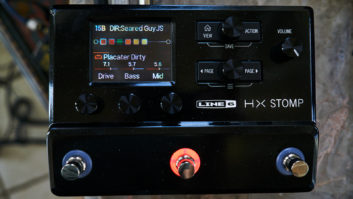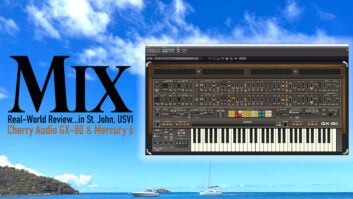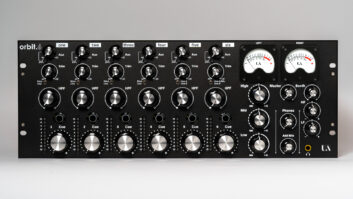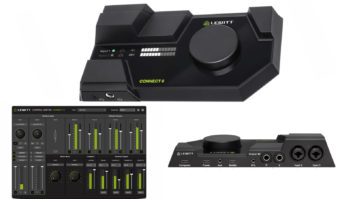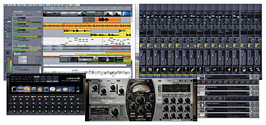

Every year, there are a few things that I can anticipate: taxes, sweltering summers in the Arizona desert and — on a positive note — a new release of SONAR. Last year, Cakewalk turbo-charged SONAR 5 as the first complete 64-bit DAW bundled with Roland V-Vocal VariPhrase and Perfect Space Convolution Reverb, just to name a few enhancements. (See the September 2006 review.)
Cakewalk’s latest release, SONAR 6 Producer Edition, further develops the DAW with features that include a dynamic means of remapping MIDI controls called ACT (Active Controller Technology), AudioSnap audio quantizing, Session Drummer 2 virtual instrument and VC-64 Vintage Channel, a robust new plug-in. Everything I loved about SONAR 5 — including its impressive 64-bit architecture — is included in Version 6, so this review will concentrate on the new features.
SONAR 6 work environment (clockwise from top-left): Track view, Console view, VC-64 and Session Drummer 2
All of this fun happened on a PC with two dual-core 2.41GHz AMD Opteron Processor 280s with 4 GB of RAM running Windows XP Pro. I used V. 6.2, the most current SONAR update available at the time of this review. (Updates are available for download to registered users.)
OH, SNAP!
AudioSnap, one of SONAR 6’s more sophisticated features, is a collection of tools that lets users correct (or just tighten up) the timing of audio and MIDI tracks on a per-clip basis, plus a lot more. Once it determines where the beats are in an audio clip (whether recorded or imported), it provides quantizing options and then extracts the tempo for other tracks to follow. As a user of Pro Tools Beat Detective, I thought I could dive right into AudioSnap, but that wasn’t the case. I must admit that it isn’t the easiest tool to grasp. Fortunately, the install DVD provided an excellent video tutorial to get me started.
After watching the video, I recorded a bass part into SONAR with its metronome set at 100 bpm. After the recording, I noticed my timing was slightly off. I right-clicked on the clip and selected AudioSnap Enable. All of the transients were marked and the AudioSnap Palette was launched. Next, I used the Align Time Ruler feature and defined specific transients as particular beats or measures by clicking on the time line and selecting Set Measure/Beat at Now. Using this info, AudioSnap tightened up my recording and created a tempo map. To test how well other tracks could follow the map, I imported a few of the sample MIDI groove clips into the new Session Drummer 2 virtual instrument. AudioSnap aligned the imported tracks perfectly with my fixed bass part.
AudioSnap also offers a selection of time-stretching algorithms. You can turn on Auto-Stretch and audition your session at different tempos, or you can stretch a clip to fit a specific length of time, which is a great tool for a commercial spot that’s a bit long or short. Of all the features in AudioSnap, the time stretching is what required the most finesse; you must be careful in choosing the algorithms. In my experience, the online or real-time algorithms acquired many artifacts and phasing after stretching. I had much better results with offline rendering and using one of the bundled iZotope algorithms, which took about two minutes to render a one-minute clip.
AudioSnap can get pretty deep and overwhelming, especially to the first-time user. I suggest watching the video and experimenting with all of its options. Once understood, it proved to be quite powerful.
ACTIVE CONTROLLER TECHNOLOGY
Another fresh new feature of SONAR 6 is ACT (Active Controller Technology), which allows automatic or custom mapping of MIDI controllers or control surfaces to any plug-in, instrument or even a channel strip that’s active on the screen. ACT comes loaded with presets for some popular devices already, although the MIDI controller I used, the M-Audio Ozonic, did not have a preset. ACT has a preset for the M-Audio Ozone, which I tried loading, but wasn’t successful in making it work. My other option was to load a generic MIDI controller preset and map out all the controls manually. As the Ozonic has a generous 40 controllers, my test was to map out volume and pan controls for the Console view and parameter controls for the new VC-64 Vintage Channel plug-in.

The SONAR update 6.2 now offers the X-ray feature.
In attempting to work with ACT, I ran into a few problems. I mapped out the controls for my MIDI controller (MIDI Learn) and continue with an ACT Learn function for a plug-in. ACT Learn is the process of assigning plug-in parameters to the ACT Property page. In some instances, I couldn’t map the threshold setting for the VC-64’s compressor; on another occasion, I couldn’t map the release time. I also experienced loss of MIDI mappings for my controller, even after saving my own preset. I spent a considerable amount of time and effort with ACT, but it wasn’t until a complete re-install of SONAR 6.2 and few correspondences with Cakewalk’s technical support staff until ACT made sense and worked as described.
NEW SOUNDS ABOUND
The new VC-64 Vintage Channel is basically the Kjaerhus Golden Channel but re-skinned and optimized to take advantage of SONAR’s 64-bit processing engine. The VC-64 includes a gate, dual stages of compression and EQ, and a de-esser. An impressive 10 routing scenarios can be selected from filtered and parallel compression to mid-side setups, sidechaining and more. The VC-64’s presets are wonderful starting points that yield great-sounding sonic results. I quickly found a use for it on almost every track of the song I was mixing, and it became my go-to plug-in in SONAR, especially for EQ and compression.
Session Drummer 2’s UI includes a Program Browser, which allows you to easily pick the style and kit. Once a kit is selected, MIDI patterns are loaded into the browser, where you can audition eight different grooves via the transport in Session Drummer 2. If you’re not content with one of the drum components, a right-click on the drum icon lets you load in a separate drum from other kits. I could mix-and-match different drums to my liking. A separate volume, width, pan and tune control is available on each velocity-sensitive drum component, along with eight separate outputs for mixing. The only option I craved was the ability to balance room mics into the mix. Once I had a good kit for my tune and decided on a groove, I just clicked and dragged the groove into a MIDI track for editing. Session Drummer 2 is not only easy to navigate and comprehend, but it also sounds great.
RAISING THE BAR
Cakewalk packed some potent new features into SONAR 6 Producer Edition. AudioSnap is a must-have tool for quantizing audio and extracting grooves. The VC-64 Vintage Channel is an excellent-sounding plug-in with versatile routing, making it a heavy justification for upgrading. Session Drummer 2 is intuitive, sounds good and works.
My only gripe is SONAR didn’t have a preset for my controller and I had inconsistent performance with manual mapping; a re-install of 6.2 fixed the issues. Fair warning, ACT took a bit of time to set up and users should definitely read up before diving in. Once set up, ACT can really enhance workflow.
I also enjoyed other more modest upgrades. The Console view has been redesigned and is now much easier on the eyes, and the mouse-wheel functions have been enhanced for zooming in and out on tracks. Also, in the Track view the mouse wheel can control all knobs and faders. One V. 6.2 update that I absolutely love is the X-ray Window, which eliminates the need to move, close or minimize windows so that you can see other windows. Simply hovering over a window and striking Shift + x fades the top window enough to see the underlying window for control. Priceless!
If you crave a more stripped-down version that’s lighter on the checkbook, check out SONAR Studio Edition. Some of the bigger omissions are AudioSnap, Roland V-Vocal and surround mixing. Plug-ins and instruments are also scaled back — VC-64 Vintage Channel, Session Drummer 2, Perfect Space Reverb, Lexicon Pantheon Reverb, Pentagon I and PSYN II are missing.
There is much to love about SONAR 6. Even the price (Producer Edition, $619; Studio Edition, $369) has dropped in comparison with previous releases. And with the scalability of Studio Edition, Cakewalk’s flagship product has much to offer the producer/engineer at any level.
Cakewalk, 617/423-9004, www.cake walk.com.
Tony Nunes is an audio engineer, teacher and new daddy to Luc.

Download white paper on benefits of 64-bit CPUs here.
